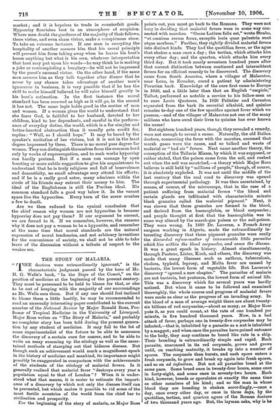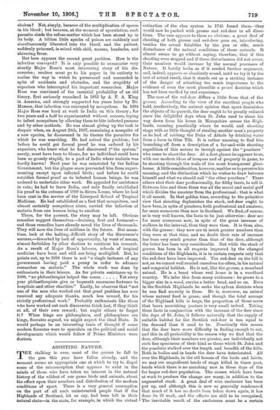THE STORY OF MALARIA.
" rillHE doctors were extraordinarily ignorant," is the characteristic judgment passed by the hero of Mr. H. G. Wells's book, "In the Days of the Comet," on the position of medicine at the beginning of the present century. They must be presumed to be held to blame for that, or else to be out of keeping with the majority of our surroundings as Mr. Wells sees them. But if any one should feel inclined to blame them a little hastily, he may be recommended to read an unusually interesting paper contributed to the current number of the National Review by Major Ronald Ross, Pro- fessor of Tropical Medicine in the University of Liverpool. Major Ross writes on "The Story of Malaria," and probably no completer story has been told during the present genera- tion by any student of medicine. It may fall to the lot of some experimentalist of the future to be able to announce the discovery of a certain cure for cancer, and to be able to write an essay summing up the etiology as well as the ascer- tained methods of stamping out that hideous disease. But though such an achievement would mark a magnificent epoch in the history of medicine and mankind, its importance might possibly be exaggerated in comparison with the achievements of the students of the etiology of malarial fevers. Is it generally realised that malarial fever "destroys every year a population equal to that of London" P When it is under- stood what that means, it is easier to estimate the import- ance of a discovery by which not only the disease itself can be prevented, but which makes it possible to rid some of the most fertile countries of the world from the chief bar to civilisation and prosperity.
For the beginning of the story of malaria, as Major Ross
points out, you must go back to the Romans. They were not long in deciding that malarial fevers were in some way con- nected with marshes. "Omne Latium fella est," wrote f3trabo,
"et omnium rerum ferax, exceptis locis quae palustria stint atque morbosa." Further, they rightly divided malarial fevers into distinct kinds. They had the quotidian fever, or the ague that shakes a man once a day ; the tertian, which attacks him every other day; and the quartan, which attacks him every third day. But it took nearly seventeen hundred years after that correct distinction between continued and intermittent fevers for an efficient remedy to be discovered. The discovery came from South America, where a villager of Malacotos, near Loxa,, in Ecuador, cured a patient by administering Peruvian bark. Knowledge of the cure first came to Europe in 1640, and a little later than that an English "empiric," Talbot, performed so notable a service to his fellow-men as to cure Louis Quatorze. In 1820 Pelletier and Caventon separated from the bark its essential alkaloid, and quinine remains to-day one of the few specifics against fever which we possess,—and of the villager of Malacotos not one of the many millions who have owed their lives to quinine has ever known the name!
But eighteen hundred years, though they revealed a remedy, were not enough to reveal a cause. Naturally, the old Italian doctors, connecting the fever with the marshes, assumed that marsh gases were the cause, and so talked and wrote of malarial or "bad air" fevers. Next came another theory, the conception of the Telluric Miasm, by which it was supposed, or rather stated, that the poison came from the soil, and rushed out when the soil was scratched,—a theory which Major Ross believes is still held by "millions of people," though, of course, it is absolutely exploded. It was not until the middle of the last century that the real road to discovery was opened through experimental pathology. It was then ascertained, by means, of course, of the microscope, that in the case of a patient suffering from malarial fevers "the blood and certain glands are infiltrated with characteristic minute black granules called the malarial pigment." Next, it was shown that these granules are formed in the blood, and derived from the haemoglobin, or blood corpuscles ; and people thought at first that the haemoglobin was in some way altered by the marsh-gas poison or the soil-poison. They were wrong. In 1880 Dr. Laveran, a French Army surgeon working in Algeria, made the extraordinarily in- teresting discovery that these pigment granules were really the discarded refuse-matter of innumerable little parasites which live within the blood corpuscles, and cause the disease. It was a great epoch in history. Almost simultaneously, through Pasteur, Lister, Koch, and others, the discovery was made that many illnesses such as anthrax, tuberculosis, cholera, typhoid, leprosy, and Malta fever are caused by bacteria, the lowest form of vegetable life. But Laveran's discovery "opened a new chapter." The parasites of malaria are not bacteria, but protozoa, the lowest form of animal life. This was a discovery which for several years was hardly noticed. But when it came to be followed and examined thoroughly, the whole course and progress of malarial fevers were made as clear as the progress of an invading army. In the blood of a man of average weight there are about twenty- six billions of red corpuscles,—about as many, as Major Ross puts it, as you could count, at the rate of one hundred per minute, in five hundred thousand yearn. Now, in a bad attack of fever, perhaps one in twenty-five corpuscles may be infected,—that is, inhabited by a parasite as a nut is inhabited by a maggot; and when once the parasites have gained entrance to the body, they may continue to breed like rata in a ship. Their breeding is extraordinarily simple and rapid. Each parasite, ensconced in its red corpuscle, grows and grows until, on reaching maturity, it breaks up into a number of spores. The corpuscle then bursts, and each spore enters a fresh corpuscle, to grow and break up again into fresh spores, and so on ad infinitum. But not all parasites breed at the same pace. Some breed once in twenty-four hours, some once in forty-eight, and some once in seventy-two hours. Each kind, however, breeds or sporulates at exactly the same time as other members of his kind; and so the man in whose blood they are breeding is shaken accordingly,—once a day, once every other day, or once in three days, by the quotidian, tertian, and quartan agues of the Roman doctors of two thousand years ago. But, the layman asks, why is he
shaken? Not, simply, because of the multiplication of spores in his blood ; but because, at the moment of sporulation, each parasite sheds the ref use•matter which has been stored alp in its body. A billion little specks of poison are suddenly and simultaneously liberated into the blood, and the patient, suddenly poisoned, is seized with chill, nausea, headache, and shivering fever.
But here appears the second great problem. How is the infection conveyed P It is only possible to summarise very shortly Major Ross's most interesting story of his dis- coveries; readers must go to his paper in its entirety to realise the way in which he persevered and succeeded in spite of accidents and obstacles, and the stupidity of superiors who interrupted his important researches. Major Ross was convinced of the essential probability of an old theory, first seriously examined in 1883 by A. P. A. King in America, and strongly supported ten years later by Dr. Manson, that infection was conveyed by mosquitoes. In 1894 Major Ross was hard at work in India on this theory; for two years and a half he experimented without success, trying to infect mosquitoes by allowing them to bite infected persons and by other methods. He was almost giving up the task in despair when, on August 20th, 1897, examining a mosquito of a new species, he discovered in its tissues the parasites for which he was searching. He had solved the problem ; but before he could get formal proof he was ordered by his superiors, who knew what he had discovered (" the system," surely, must have been to blame, for no individual could have been so grossly stupid), to a part of India where malaria was hardly known! Next year he was reinstated by the Indian Government, but the plague scare prevented him from experi- menting except upon infected birds ; and before he could establish formal proof as to infected human beings, he was ordered to undertake other work. He appealed for assistance in vain; he had to leave India, and only finally established his proof in the autumn of 1899 in Sierra Leone, where he had been sent in the service of the Liverpool School of Tropical Medicine. He had established as a fact that mosquitoes, and almost certainly mosquitoes alone, carried the infection of malaria from one human being to another.
There, for the present, the story may be left. Obvious remedies suggest themselves—draining, first and foremost— and those remedies have already saved the lives of thousands. They will save the lives of millions in the future. But mean- time, look at the halting, difficult story of the discoverer's success,—thwarted by lack of opportunity, by want of means, almost forbidden by other doctors to continue his research. As a result of Major Ross's labours, schools of tropical medicine have been and still are being multiplied. But, ho points out, up to 1898 there is not "a single instance of any government having paid a penny in order to advance researches on malaria." The whole work was done by enthusiasts in their leisure. As for private assistance up to
1898, "no philanthropist helped the cause Yet every year philanthropists give or bequeath enormous fortunes to hospitals and other charities." Lastly, he observes that "not one of the men who worked out that great problem has ever received any adequate thanks, much less reward, for his strictly professional work." Probably enthusiasts like those who have worked out such discoveries think last, if they think at all, of their own reward; but ought others to forget it ? When kings are philosophers, and philosophers are kings, Socrates argued, we might expect the ideal State. It would perhaps be an interesting train of thought if some modern Socrates were to speculate on the political and social developments which would follow if Prime Ministers were doctors.















































 Previous page
Previous page